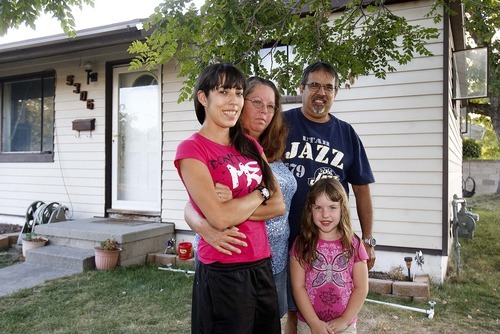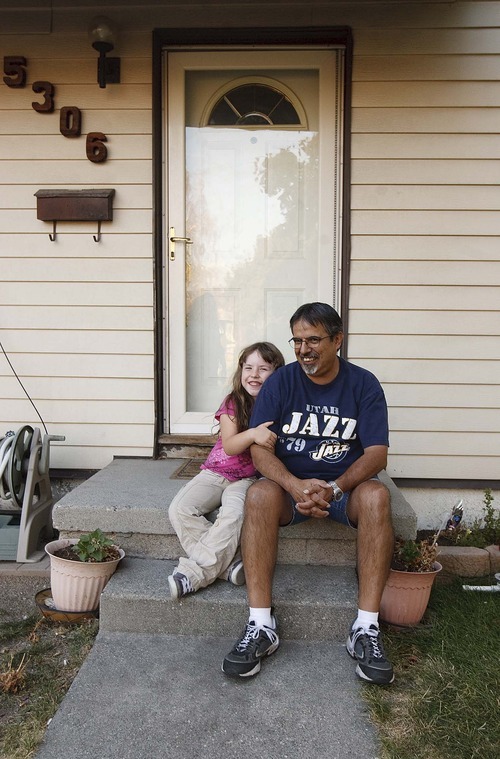This is an archived article that was published on sltrib.com in 2011, and information in the article may be outdated. It is provided only for personal research purposes and may not be reprinted.
The small three-bedroom, one-bath home in Kearns where Lee and Lynette Martinez have lived the past 35 years would have plenty of room for them — except that tough times have sometimes forced their three adult children along with their families to return to live there, too.
"At one point, we had 10 people living here," including four couples, some children and a couple of dogs, Lee Martinez said.
One couple slept in a travel trailer in the driveway. "We only have one bathroom, so I had to get up really early to get my 10-minute turn there," he said. "Somebody was always up because we worked different shifts. ... It was crowded, but it was nice having my granddaughters around."
The Martinez family is an example of a growing trend of families doubling, tripling or even quadrupling up in homes to save money and survive during tough economic times.
One way that the U.S. Census Bureau measures that is to count households where at least three generations live together.
A Salt Lake Tribune analysis of recently released 2010 Census data shows that such multigenerational households grew by 50 percent in Utah during the past decade — from 25,673 to 38,852.
About one of every 21 households in Utah, or 4.6 percent, has three generations or more living together. That is up from 3.7 percent in 2000.
The rate is much higher in some places. Among communities of at least 5,000 residents, Kearns — where the Martinez family lives — has the highest rate in the state. One of every 10 households there, or 10.2 percent, is multigenerational.
Other communities high on that list include: West Valley City, 9.2 percent of all households; Bluffdale, 8.4 percent; Magna, 8.3 percent; and White City, 7.9 percent.
Pam Perlich, research economist at the University of Utah, said households that become multigenerational often do it for cultural reasons as well as economic ones, "and sometimes they are intertwined and it is hard to unravel them."
For example, the Utah areas with the highest rates of multigenerational families are in small villages on the Navajo and Ute reservations — and much of that is by tradition and culture, Perlich said. Places such as Kearns and West Valley also have large Latino populations, and Perlich said it is also part of some Latino cultures to have extended families live together.
Among newer immigrants — and Kearns and West Valley have large populations of them — Perlich said they often combine households to provide child care, take care of the elderly and save money.
But she notes many families also are forced into living together strictly for financial reasons. She said research has shown that much of the recent immigration to Utah, for example, is by adult children who lost jobs elsewhere and have moved home to live with parents.
Martinez said his family combined households "strictly for economic reasons. When someone lost a job, they moved in to save money. When they found jobs, they would move back out." Currently only one daughter and her family lives with him.
His wife, Lynette, said, "If you can't turn to family, who can you turn to? We have a huge sense of family and want to take care of each other."
Despite crowding, Lynette said, "To me, it has been worth it. It gives kids the chance to get back on their feet and then spread their wings and go on their own again."
Showing that multigenerational families are found among people of sometimes unexpected backgrounds, Jim Wood, director of the Bureau of Economic and Business Research at the University of Utah said, "I was talking with 12 economists the other day, and three had people living back home with them. It's not quite what we expected in our golden years."
The Census numbers show just a part of all those who are doubling up. Many who do are not related to one another, so the Census count of multigenerational families does not capture them.
For example, Perlich said many married graduate students at the U. have told her "that they have doubled up, or even tripled up, with other grad students who are married, maybe living in the basement of a home with them."
Data released last week by the Census Bureau's Current Population Survey estimated that the number of doubled-up households — which have a non-student adult who is not the spouse or partner of the householder — has increased by 10.7 percent nationally between when the recession began in 2007 and now, totaling 21.8 million households. With that, the survey said about 30 percent of all U.S. adults are "doubled-up" now. It also said that the number of 25- to 34-year-olds living with parents nationally has increased by 25.5 percent since 2007 to 5.9 million.
The report did not include state-by-state numbers, but the Community Action Partnership of Utah has noted up to 10 percent of the 718 households it has served since October 2009 are in a doubled-up situation, primarily because of under- and unemployment.
Of most concern is the skewing effect on the picture of poverty, said Drew Martinez, senior policy analyst for the organization. "If you have high- and low-income families in the same household, that is masking the low-income family's situation."
The census said the official poverty rate in households with young adults living with their parents is 8.4 percent but based on only their own income, 45.3 percent would fall below the poverty threshold.
Christian Clark of Salt Lake City is among the young adults moving back home.
Clark, 32, moved out of his parents' home more than a decade ago. In 2009, he graduated from the U. with a bachelor of fine arts in vocal performance, and set out to pursue his dream of becoming an opera singer. Clark took a job at a local call center while also auditioning for and landing singing gigs. But in May 2010, he was let go and, despite sending out hundreds of résumés since then, has been able to find only temporary work. Unable to pay rent any longer, Clark is moving back into his mother's home in Orem.
"Hopefully, it's short term," said Clark. "Frankly, I've always been able to take care of myself, but with the economy being the way it is, being able to take care of yourself is a lot more difficult."
Merrilee Clark, his mother, has had her own challenges during the recession. Already a CPA, she added a law degree in 2009 but has had to rely mostly on accounting work given the tough market for attorneys. Still, she's economically stable, unlike her son at the moment.
"I worry that he might be feeling like a failure, but I'm glad that I have the ability, the room for him to move back," Merrilee Clark said. "It is important for family to take care of family. We should be the safety net."





